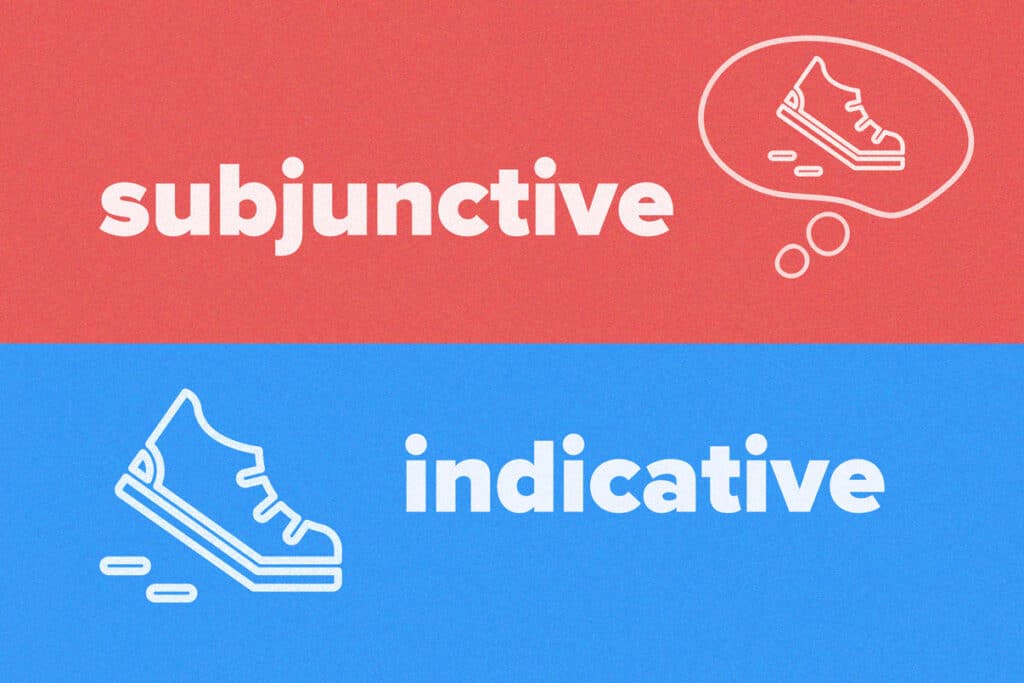
Subjunctive vs. Indicative Spanish Moods
The subjunctive and indicative are two of the three Spanish moods, and differentiating between them can be tricky.
While the indicative is what you typically learn first—including the present, preterite and imperfect tenses—the subjunctive is commonly used by native speakers to express wishes, hopes, desires, doubts and more.
In this post, you’ll learn the key differences between the indicative vs. subjunctive Spanish moods.
You’ll also learn when to use each one, see example sentences and discover useful practice resources for mastering both.
Contents
- Subjunctive vs. Indicative Spanish: The Key Differences
- Actions (Indicative) vs. Thoughts About Actions (Subjunctive)
- Beliefs (Indicative) vs. Doubts (Subjunctive)
- Sentences with “I would…” (Indicative) vs. “I want…” (Subjunctive)
- Talking About Actions: Yours (Indicative) vs. Others’ (Subjunctive)
- Discussing Situations: Realistic (Indicative) vs. Imaginary (Subjunctive)
- Making Requests: Direct (Indicative) vs. Polite (Subjunctive)
- Subjunctive vs. Indicative: Common Words and Phrases
- Resources for Practicing the Spanish Indicative vs. Subjunctive Moods
- And One More Thing…
Download: This blog post is available as a convenient and portable PDF that you can take anywhere. Click here to get a copy. (Download)
Subjunctive vs. Indicative Spanish: The Key Differences
There are three moods in Spanish: indicative, subjunctive and imperative. A mood is a category of verb tenses that indicate the attitudes and intentions of the speaker.
The subjunctive mood expresses:
- wishes
- emotions
- impersonal expressions
- recommendations
- doubts/denial
- phrases that begin with ojalá (I hope)
While the indicative mood is used to talk about:
- facts
- objective reality
Here are some sentences in the subjunctive mood:
Ella quiere que su hermano ande en bicicleta.
(She wants her brother to ride his bike.)
Ojalá que vayamos a la playa.
(I hope we go to the beach.)
And some in the indicative mood:
Ella quiere ir a la playa.
(She wants to go to the beach.)
Mañana mi hermano y yo jugaremos al futbol.
(Tomorrow, my brother and I will play soccer.)
Actions (Indicative) vs. Thoughts About Actions (Subjunctive)
In any beginner Spanish class, you’ll learn to describe your own actions and other people’s actions using the indicative mood.
Ella lee el diário cada día.
(She reads the newspaper every day.)
Ustedes toman el autobús.
(You guys take the bus.)
Tú siempre dices la verdad.
(You always tell the truth.)
Ellas van al doctor.
(They go to the doctor.)
However, when commenting on these actions—expressing likes, dislikes, preferences and other opinions—you’ll need to change these verbs into the subjunctive mood.
A mí me gusta que ella lea el diário cada día.
(I like that she reads the newspaper every day.)
La profesora sugiere que ustedes tomen el autobús.
(The professor suggests that you guys take the bus.)
Yo respeto que tú siempre digas la verdad.
(I respect that you always tell the truth.)
Es importante que ellas vayan al doctor.
(It’s important that they go to the doctor.)
Beliefs (Indicative) vs. Doubts (Subjunctive)
We might think that beliefs are more like opinions rather than objective facts. But in Spanish, you must use the indicative mood to talk about positive beliefs.
Yo creo que ella volverá a casa esta noche.
(I believe that she’ll come home tonight.)
On the other hand, if someone’s expressing doubt or uncertainty, use the subjunctive mood.
Yo no creo que ella vuelva a casa esta noche.
(I don’t believe that she’ll come home tonight.)
Here, what’s important isn’t the truth of the claim—it’s the person’s perception of the situation.
If you’re expressing a positive belief, use the indicative. If you’re expressing doubt, use the subjunctive.
For a real-life example, check out the song “Lo dudo” (I Doubt It) by Argentine singer Karina la Princesita.
Notice in the lyrics that she uses the subjunctive to follow up the phrase dudo que (I doubt that) but the indicative to follow up sé que (I know that).
Sentences with “I would…” (Indicative) vs. “I want…” (Subjunctive)
The conditional tense (the Spanish equivalent of the English phrase “I would…”) is indicative.
So, when talking about what you or others would do in a given situation, use the conditional tense rather than the subjunctive.
Yo haría lo mismo en su situación.
(I’d do the same in her situation.)
Very frequently, you’ll see a conditional verb accompanied by a subjunctive verb when trying to express things in an “if…then” format:
Si ella tuviera que mudarse, se iría a Londres.
(If she had to move, she’d go to London.)
Here, the verb tuviera (had) is the past subjunctive and se iría (would go) is the conditional.
On the other hand, when talking about wants or desires, use the subjunctive.
In these situations, you can frequently tell that you need to use the subjunctive when you see the word que (that). For example:
Yo quiero que tú me hables.
(I want you to talk to me.)
Él espera que nosotros vengamos a su fiesta de cumpleaños.
(He hopes that we’ll come to his birthday party.)
Talking About Actions: Yours (Indicative) vs. Others’ (Subjunctive)
This is a slight caveat to the previous rule about wishes, wants, preferences and desires.
When somebody’s commenting on their own actions, there’s no need for the subjunctive. Instead, use the infinitive form.
Yo quiero viajar a Irlanda.
(I want to travel to Ireland.)
Mis padres prefieren cenar temprano.
(My parents prefer to eat dinner early.)
If you were expressing a desire for somebody else to do something, you’d use the subjunctive.
For example:
Yo quiero que mi hermana viaje a Irlanda.
(I want my sister to travel to Ireland)
Mis padres prefieren que tú cenes temprano.
(My parents prefer that you eat dinner early.)
As a general rule, don’t use the subjunctive mood to talk about your own actions.
You might hear a few exceptions, but using the indicative would be just as correct. For example, you can say both of these sentences:
No creo que (yo) vaya al concierto.
(I don’t think I’ll go to the concert.)
No creo ir al concierto.
(I don’t think I’ll go to the concert.)
Discussing Situations: Realistic (Indicative) vs. Imaginary (Subjunctive)
If the verb you use after si talks about a future event, use the indicative mood.
Si llueve, no iremos a la playa.
(If it rains, we won’t go to the beach.)
Si ganamos el partido, celebraremos durante toda la noche.
(If we win the game, we’ll celebrate all night long.)
Even if those phrases don’t represent objective facts, they do represent realistic situations.
On the other hand, you can use the subjunctive mood to slightly change the meaning of your sentence and express unlikely or impossible circumstances.
Si lloviera, no iríamos a la playa.
(If it rained, we wouldn’t go to the beach.)
To go a step further, you can use a pluperfect subjunctive conjugation to describe an entirely imaginary, impossible situation that might have occurred but didn’t.
Si hubiera llovido, no habríamos ido a la playa.
(If it had rained, we wouldn’t have gone to the beach.)
Making Requests: Direct (Indicative) vs. Polite (Subjunctive)
Usually, Spanish commands are made using the imperative mood—something entirely different from the indicative and subjunctive.
However, if you want to be more formal and polite, you can use the subjunctive to sound softer and more respectful.
The easiest way to do this is to use quisiera (I want) or si pudieras.
Quisiera que me pase el sal.
(I’d like for you to pass me the salt.)
¿Si pudieras, me pasarías el sal?
(If you could, would you pass me the salt?)
You can also make requests using poder in the indicative present tense:
¿Puedes ayudarme?
(Can you help me?)
¿Puedo traerte una bebida?
(Can I get you a drink?)
Subjunctive vs. Indicative: Common Words and Phrases
Remembering when to use the indicative vs. subjunctive moods can be tricky.
But an easy way to keep the two moods straight is to know the “trigger phrases” commonly associated with one mood or the other.
“Triggers” are words and phrases that, when used in a sentence, usually tell you which mood or tense you should use.
You may have already noticed a few of these triggers throughout this article.
Some common phrases that go with the indicative mood are:
- creer (to believe)
- decir (to say)
- es cierto que (it’s certain that)
- es claro que (it’s obvious that)
And the common trigger words for the subjunctive mood are:
- desear (to desire)
- querer (to want)
- dudar (to doubt)
- sugerir (to suggest)
- me gusta que (I like that)
- es importante que (it’s important that)
Resources for Practicing the Spanish Indicative vs. Subjunctive Moods
- SpanishDict. SpanishDict has a great list of trigger words for both subjunctive and indicative moods.
- Quizlet. For even more phrases—and to work on your recall—check out some Quizlet sets on subjunctive and indicative triggers.
- FluentU. You can also listen to native speakers using these two grammar structures with short Spanish videos on FluentU.
FluentU takes authentic videos—like music videos, movie trailers, news and inspiring talks—and turns them into personalized language learning lessons.
You can try FluentU for free for 2 weeks. Check out the website or download the iOS app or Android app.
P.S. If you decide to sign up now, you can take advantage of our current sale!

- Practice exercises. Finally, try some practice exercises when you feel ready!
As you can see, the difference between subjunctive and indicative is much more complicated than just “reality” vs. “opinions.”
But with these rules in mind and practice resources in hand, you’ll be better able to differentiate between the two in no time.
And choose the correct one to express yourself like a native speaker!
Download: This blog post is available as a convenient and portable PDF that you can take anywhere. Click here to get a copy. (Download)
And One More Thing…
If you've made it this far that means you probably enjoy learning Spanish with engaging material and will then love FluentU.
Other sites use scripted content. FluentU uses a natural approach that helps you ease into the Spanish language and culture over time. You’ll learn Spanish as it’s actually spoken by real people.
FluentU has a wide variety of videos, as you can see here:

FluentU brings native videos within reach with interactive transcripts. You can tap on any word to look it up instantly. Every definition has examples that have been written to help you understand how the word is used. If you see an interesting word you don’t know, you can add it to a vocab list.

Review a complete interactive transcript under the Dialogue tab, and find words and phrases listed under Vocab.

Learn all the vocabulary in any video with FluentU’s robust learning engine. Swipe left or right to see more examples of the word you’re on.

The best part is that FluentU keeps track of the vocabulary that you’re learning, and gives you extra practice with difficult words. It'll even remind you when it’s time to review what you’ve learned. Every learner has a truly personalized experience, even if they’re learning with the same video.
Start using the FluentU website on your computer or tablet or, better yet, download the FluentU app from the iTunes or Google Play store. Click here to take advantage of our current sale! (Expires at the end of this month.)









